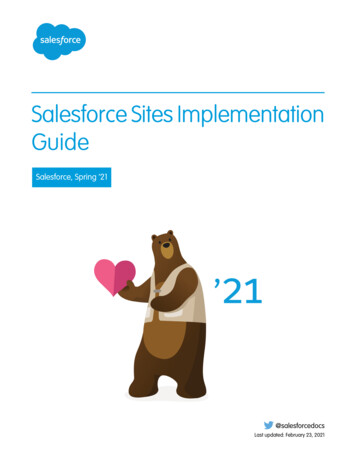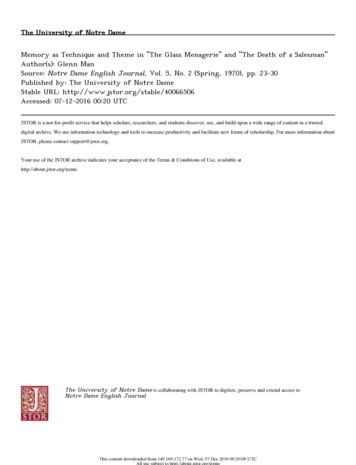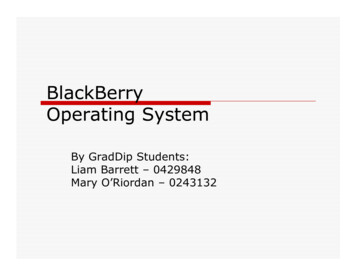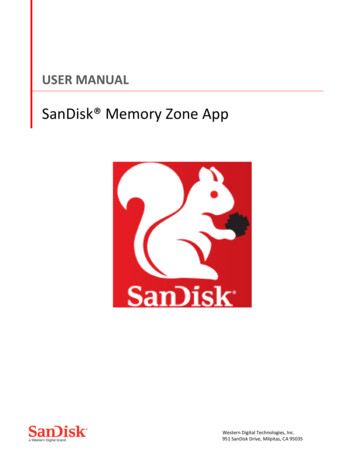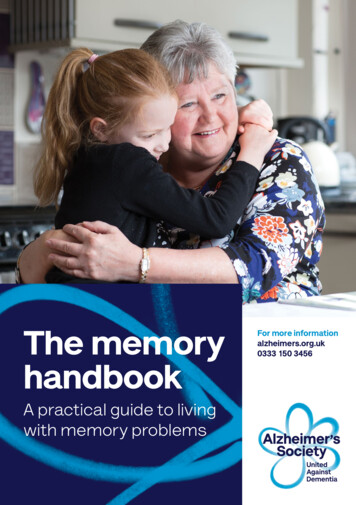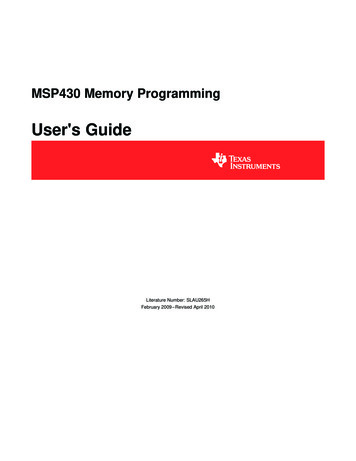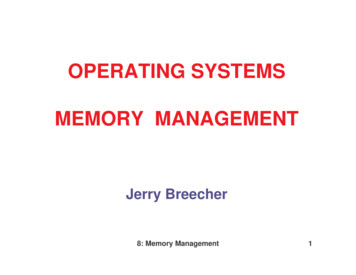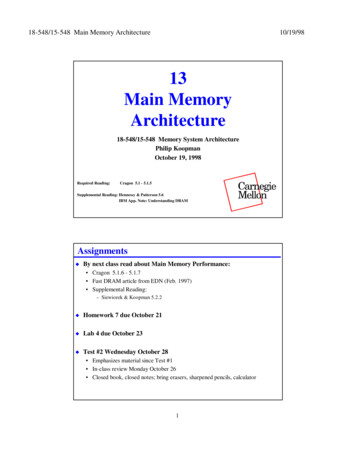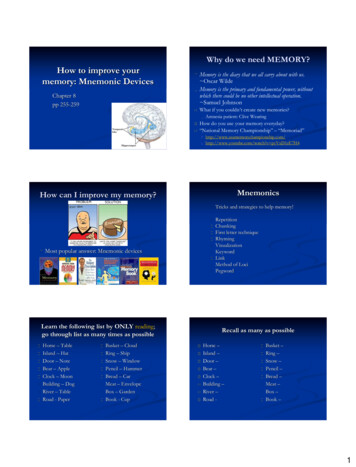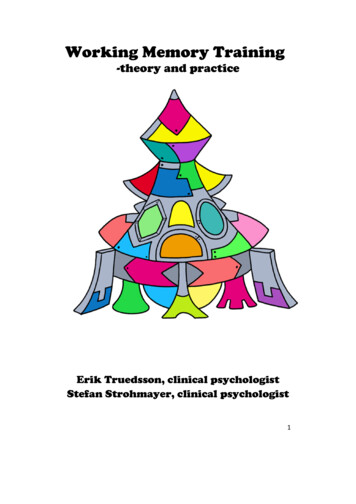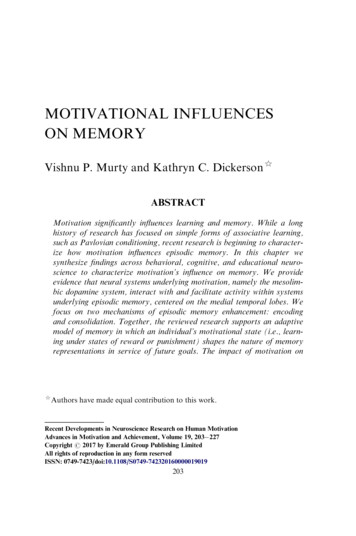
Transcription
MOTIVATIONAL INFLUENCESON MEMORYVishnu P. Murty and Kathryn C. Dickerson ABSTRACTMotivation significantly influences learning and memory. While a longhistory of research has focused on simple forms of associative learning,such as Pavlovian conditioning, recent research is beginning to characterize how motivation influences episodic memory. In this chapter wesynthesize findings across behavioral, cognitive, and educational neuroscience to characterize motivation’s influence on memory. We provideevidence that neural systems underlying motivation, namely the mesolimbic dopamine system, interact with and facilitate activity within systemsunderlying episodic memory, centered on the medial temporal lobes. Wefocus on two mechanisms of episodic memory enhancement: encodingand consolidation. Together, the reviewed research supports an adaptivemodel of memory in which an individual’s motivational state (i.e., learning under states of reward or punishment) shapes the nature of memoryrepresentations in service of future goals. The impact of motivation on Authors have made equal contribution to this work.Recent Developments in Neuroscience Research on Human MotivationAdvances in Motivation and Achievement, Volume 19, 203 227Copyright r 2017 by Emerald Group Publishing LimitedAll rights of reproduction in any form reservedISSN: 0749-7423/doi:10.1108/S0749-742320160000019019203
204VISHNU P. MURTY AND KATHRYN C. DICKERSONlearning and memory, therefore, has very clear implications for andapplications to educational settings.Keywords: Medial temporal lobe; hippocampus; ventral tegmentalarea; amygdala; reward; punishmentMotivation is central to human behavior: it affects the decisions we make,the experiences we seek, and consequently what we encode and remember.We often experience ease in remembering something we are motivated todo (e.g., fill out the adoption paperwork for a new puppy), but difficulty inremembering something we are unmotivated to do (e.g., fill out tediousforms at work). Although an extensive literature from behaviorists andlearning theorists has studied how learning and memory can be influencedvia reinforcement and feedback (Bouton, 2007), relatively little research hasfocused on how motivational drive influences memory. Similarly, a longhistory of educational psychology has investigated how feedback and performance testing influence learning (Darling-Hammond, 1994; Kluger &DeNisi, 1996), with comparatively less research investigating how leveraging students’ motivational states can facilitate better learning. An emerging literature based on behavioral and cognitive neuroscience, however,has begun to explore the determinants of memory success as they relate tomotivation, which has broad implications for and applications to educational settings.In this chapter, we describe the neural circuitry involved in motivatedmemory and provide empirical evidence characterizing how motivationdirectly influences both what and how we remember. We particularly focuson how motivation influences declarative and episodic memory systems.These systems not only support our memory for events but also influencehow we retrieve memories to support a variety of adaptive behaviorsincluding reasoning, conceptual knowledge, creativity, decision-making,and future-oriented thinking (Shohamy & Turk-Browne, 2013). To betterunderstand these systems, we integrate converging evidence across animalmodels and human research that supports a role for motivation in influencing multiple stages of memory, including encoding and consolidation.Furthermore, we delineate how different types of motivational states (e.g.,anticipated reward vs. punishment) recruit distinct neural networks to
Motivational Influences on Memory205shape what we learn and remember. Lastly, we discuss the implications ofthese findings for education.NEUROANATOMICAL SUBSTRATES OFMOTIVATED MEMORYA substantial body of evidence converging from animal models and humanliterature implicates the medial temporal lobe (MTL) in memory processes.The MTL consists of the hippocampus and the surrounding parahippocampal gyrus, including perirhinal cortex, parahippocampal cortex, entorhinalcortex, and subiculum. Some of the earliest evidence supporting the role ofthe MTL in memory came from human patients with damage to the MTLwho exhibited profound loss of episodic memoriesboth an inability torecall past events (retrograde amnesia) and an inability to form new memories (anterograde amnesia) (Squire, 1992). Subsequent animal studieswhich lesioned or temporarily inactivated parts of the MTL corroboratedhuman patient evidence that the MTL is necessary for episodic memoryencoding (Eichenbaum, Yonelinas, & Ranganath, 2007). Furthermore,functional magnetic neuroimaging (fMRI) studies investigating humanmemory support a role for the MTL in both episodic encoding and retrieval (Kim, 2011; Spaniol et al., 2009).While the entirety of the MTL is known to support declarative memory,important distinctions have been made regarding the specific functions ofthe hippocampus proper versus the surrounding MTL cortex (Davachi,2006; Ranganath, 2010). Namely, these discrete regions within the MTLare thought to support different types of memories. Cortical MTL, whichincludes perirhinal and parahippocampal cortices, supports the encoding ofisolated representations of items and contexts, respectively. In contrast, thehippocampus proper supports flexible, integrative relationships betweenthese unitized constructs and binds them into flexible, mnemonic representations. For example, whereas memory for the cover of your favorite bookmay only rely on your cortical MTL, memory for the exact location inwhich you first saw that specific book cover would be supported by thehippocampus.The MTL does not act in isolation to support human behavior. It isrichly connected with a host of brain regions, including areas closely associated with motivation, such as ventral tegmental area (VTA), ventral striatum, and ventral prefrontal cortex (vmPFC), comprising what are known
206VISHNU P. MURTY AND KATHRYN C. DICKERSONas the mesolimbic (VTA to ventral striatum) and mesocortical (VTA tovmPFC) circuits, which for simplicity we refer to in this chapter collectivelyas the mesolimbic pathway (Fig. 1). Critically, the interactions of the hippocampus with regions throughout the mesolimbic circuit are thought tosupport motivation’s influence on memory. There are two predominantanimal models illustrating how interactions within the mesolimbic circuitfacilitate memory. Lisman and Grace (2005) proposed the VTA-hippocampalloop, which describes how newly detected information in the hippocampusis sent as a novelty signal via the subiculum, nucleus accumbens, andFig. 1. Key Anatomical Regions Engaged during Motivated Memory Encodingand Consolidation. Notes: The ventral tegmental area (VTA) projects dopaminethroughout the mesolimbic circuit (depicted here). The hippocampus (HPC) iscritical for long-term memory formation and creating rich memories (binding itemsin a specific context). The HPC and VTA are engaged during reward-motivatedmemory formation. The amygdala (AMY) and cortical medial temporal lobe(MTL) are engaged during punishment motivated memory encoding (e.g., shocks asopposed to rewards). The prefrontal cortex (PFC) increases signal to noise and maydistribute reward information throughout this network. The ventral striatum (VS)encodes reward valuation. The dorsal striatum (DS) is included as a reference point.Anatomical connections are adapted from Shohamy and Adcock (2010).
Motivational Influences on Memory207ventral pallidum to the VTA. Subsequently, neurons in the VTA releasedopamine (as a result of novelty signals) into terminals in the hippocampus,facilitating long-term potentiation (LTP). This model therefore emphasizesthe loop between the VTA and hippocampus as critical for (1) detectionof novel information and (2) encoding novel information into long-termmemory.An alternative model, the hippocampal/neocortical interactions theoryof memory formation proposed by Wang and Morris (2010), emphasesinteractions between the hippocampus and neocortex, rather than the VTAand hippocampus, as critical for memory formation. This model consists offour main components: encoding and storage, cellular consolidation, systems consolidation, and retrieval and reconsolidation. They propose thatencoding occurs in the hippocampus formation (HF) and consists ofenhancement of activity within cellular (neural) synapses. Cellular consolidation of memories in the HF decay rapidly, but can be augmented ifencoding co-occurs with the synthesis, distribution, and capture of newproteins at synapses, which helps to stabilize synaptic changes. Systemsconsolidation then occurs, wherein the HF establishes memory traces withrelevant regions of the cortex. Lastly, during retrieval and reconsolidation,memory traces within the HF are activated and act as a memory index,pointing to regions of the cortex where the memory is fully stored.The mesolimbic circuit is anatomically connected via dopamine efferent projections originating in the VTA. Dopamine is a neuromodulatorwith several receptor types (D1 D5), which are largely classified intoD1-like (D1, D5) and D2-like (D2, D3, D4). D1-like and D2-like receptors have opposing effects: broadly, they act to increase and decrease,respectively, the responsiveness of neurons they modulate (Pierce &Kumaresan, 2006). Dopamine neurons project from the VTA to receptors in regions throughout the mesolimbic circuit, including theMTL, striatum, amygdala, and prefrontal cortex (PFC) (reviewed byShohamy & Adcock, 2010). Dopamine is critical for memory formation,as supported by evidence from both the animal and human literature. Inthe hippocampus, dopamine is a necessary precursor for both LTP thewell-studied cellular model of learning and memoryand the maintenance of long-term memories (Lisman, Grace, & Duzel, 2011; Wang &Morris, 2010). In humans, the effect of dopamine on memory has in partbeen assessed via pharmacological interventions that act on the dopamine system, including d-amphetamine, methylphenidate, L-dopa, andtolcapone (a COMT inhibitor). On the whole, these studies have shownthat dopaminergic agonists improve delayed recall and recognition
208VISHNU P. MURTY AND KATHRYN C. DICKERSON(or have produced null effects) (Apud et al., 2006; Eckart, Fuentemilla,Bauch, & Bunzeck, 2014; Linssen, Vuurman, Sambeth, & Riedel, 2011;Murphy, Henry, & Weingartner, 1972; Rammsayer, Rodewald, & Groh,2000). Taken together, converging evidence across animal models andhuman studies suggest that dopamine facilitates episodic memory.More recently, human imaging studies using diffusion tensor imaging(DTI) and fMRI have examined the dopaminergic mesolimbic circuitin humans. Evidence suggests the VTA and neighboring substantianigra (SN) can be delineated in humans using both DTI (Chowdhury,Lambert, Dolan, & Düzel, 2013; Kwon & Jang, 2014) and resting statefunctional connectivity (Murty et al., 2014; Tomasi & Volkow, 2014).Furthermore, intrinsic connectivity between human hippocampus, VTA,and ventral striatum has been observed during rest (Kahn & Shohamy,2013), and, critically, intrinsic connectivity between the hippocampus,vmPFC, and large-scale networks has predicted individual differences inflexible learning in healthy, young adults (Gerraty, Davidow, Wimmer,Kahn, & Shohamy, 2014). In the next section, we will explore howmotivation directly impacts this mesolimbic circuit to facilitate memoryformation.MOTIVATION INFLUENCES MEMORY ENCODINGIn the past decade, scientists have been increasingly interested in understanding the effects of different types of motivational incentives onmemory encoding. The majority of studies have examined the effect ofmonetary reward motivation on memory encoding. However, there aremany other types of nonmonetary motivational incentives, includingnatural reinforcers (e.g., juice), emotional stimuli (e.g., smiling faces), andleveraging people’s innate curiosity to learn something new. Furthermore,outside of reward motivation, there are other means of motivating individuals, including punishment. Lastly, in addition to the type of motivational incentivereward or punishmentother factors significantlycontribute to the effects of motivational incentives on encoding including(1) the physiological response elicited by the incentive and (2) the neurobiological substrates engaged during encoding. In the sections below, wedescribe the effects of each of these motivational incentives in detail,including their influence on both behavior and the neural substratesengaged during encoding.
Motivational Influences on Memory209Effects of Monetary Reward Motivation on Memory PerformanceThere is increasing evidence in the literature that monetary reward boostsmemory for reward-incentivized stimuli (for review, see Miendlarzewska,Bavelier, & Schwartz, 2016). Some studies have incentivized each item tobe remembered (e.g., 2 for remembering an upcoming scene), othershave directly associated the items with reward (e.g., all animate objectsare rewarded) and finally, some have placed items in a rewarding context(e.g., items shown within a high or low reward state). In an exemplar study,Adcock, Thangavel, Whitfield-Gabrieli, Knutson, and Gabrieli (2006)incentivized items to be remembered with either a high ( 5) or low ( 0.10)monetary reward, and paid participants their full earnings based on memory accuracy on a recognition test the following day. Similarly, Wolosin,Zeithamova, and Preston (2012) incentivized pairs of items with either high( 2) or low ( 0.10) monetary reward and paid participants a percentage oftheir earnings based on memory accuracy. As expected, in both studies,memory was enhanced for high-rewarded compared with low-rewardedmemoranda.In addition to these results, similar findings have been observed whenstimuli are incidentally learned (i.e., participants are unaware that they willtake a memory test later), rather than intentionally learned (participants areexplicitly told their memory will be tested). For example, Wittman and colleagues (2005) adapted a speeded button press task, such that each cuepicture belonged to a category (animate or inanimate). The category predicted the possibility of receiving a reward, contingent on participants’successful button press within the allotted time. Participants thereforeboth anticipated the opportunity to earn a reward and received feedbackindicating whether their response was correct or incorrect (rewarded orunrewarded). Memory in a surprise, subsequent memory test was enhancedfor reward-predictive compared with non-reward-predictive items. In a subsequent study in which the stimuli were emotional images (positive, negative, or neutral), incidental memory was better for positive-rewarded imagescompared with the positive-unrewarded images, with no effect of reward onnegative or neutral images (Wittmann, Schiltz, Boehler, & Düzel, 2008).Mather and Schoeke (2011) observed that in studies manipulating bothreward anticipation and reward outcome (Wittmann et al., 2005, 2008), theboost in memory due to reward could be caused by the effects of rewardanticipation, reward outcome, or both anticipation and outcome. To clarifythese findings, Mather and Schoeke (2011) embedded novel stimuli withina cued reaction time task. Participants first saw a cue that predicted the
210VISHNU P. MURTY AND KATHRYN C. DICKERSONpotential to earn a monetary reward ( 0.25), avoid a monetary loss ( 0.25),or obtain no outcome ( 0). They were instructed to press a button as soonas possible when a novel stimulus appeared in order to earn money, avoidmonetary loss, or achieve neither monetary gain or loss (control trials).During a surprise memory test, the authors observed that memory was betterfor items associated with positive outcomes (both gaining 0.25 and avoidinglosing 0.25) compared with negative outcomes, regardless of whether ornot the positive outcome resulted in an actual monetary gain. These resultssuggest that in paradigms where there are both reward anticipation andbehavior-contingent outcomes, the observed boost in memory may be due topositive outcomes rather than reward anticipation or reward receipt.Lastly, the effect of embedding items within a rewarding context hasbeen examined. In one such study, Murty and Adcock (2014) embeddednovel items in a stream of repeated items under states of high ( 2.00) andlow reward ( 0.10). In a surprise memory test, memory of the novel itemswas better in the high reward condition compared to both the low rewardcondition and compared to chance performance, whereas memory in thelow reward condition was no better than chance.In sum, monetary reward boosts encoding of declarative memory viaeffects of reward anticipation (Adcock et al., 2006; Wolosin et al., 2012),receipt of positive outcomes (Mather & Schoeke, 2011; Wittmann et al.,2005, 2008), and presentation in a rewarded context (Murty & Adcock,2014). In the next section, we examine the effects of monetary reward motivation on the underlying neural circuitry that may drive these observedbehavioral enhancements.Effects of Monetary Reward Motivation on Neural Systems UnderlyingMemory EncodingResults from neuroimaging studies consistently demonstrate activation ofthe dopaminergic midbrain: in particular, the VTA and hippocampus havebeen observed during monetary reward-motivated memory (for review, seeMiendlarzewska et al., 2016). Interestingly, not only does the magnitude ofactivation within these individual regions predict reward enhancements onmemory, but, critically, the strength of the correlation between VTA andhippocampus activation predicts the memory benefit due to reward(Adcock et al., 2006). These findings suggest that the interactions betweenthe VTA and hippocampus described in animal models are preserved inhumans and support reward-motivated memory.
Motivational Influences on Memory211In addition to subcortical areas, regions of the PFC have been shown tointeract with the VTA and hippocampus to promote reward-related memoryformation (Cohen, Rissman, Suthana, Castel, & Knowlton, 2014; Murty &Adcock, 2014). The ventrolateral PFC has been shown to be engaged duringencoding of high-value words and correlated with memory selectivity forhigh-valued words (Cohen et al., 2014). Further, correlated activity betweenthe VTA and PFC regions predict reward-related hippocampal signals(Murty & Adcock, 2014). Relatedly, it has been observed that reward information is communicated to subcortical areas (including the VTA and ventralstriatum) via the PFC (Ballard et al., 2011), which could act as an executivesignal to initiate processes enhancing memory for rewarding events.Notably, the regions described above are within the mesolimbic network. It is hypothesized that the rewarded memory benefit is due toreward-induced increases in dopamine within the network, which facilitatesLTP of memoranda. However, evidence to support this hypothesis is tangential at present and includes primarily genetic indices of individual differences in dopamine. In one study, participants were given L-dopa (theprecursor to dopamine) while performing a motivated memory paradigm(Sumner, Duffy, Chen, & Adcock, 2013). The authors observed that individuals with low baseline memory performance, as well as genetic profilescores and personality/symptom questionnaires associated with low dopaminergic tone, benefited the most from L-dopaspecifically, the drugincreased memory for high-rewarded scenes in these individuals. However,no memory boost was observed with L-dopa in individuals with high baseline memory performance. Similarly, administration of L-dopa has beenassociated with better episodic memory performance during incidentalencoding (Eckart et al., 2014). These studies emphasize that the impact ofdopamine on memory performance varies across individuals depending ona variety of factors including genetics and personality traits. Furthermore,these experiments lay the foundation for future work, including directmeasurements of dopamine using PET imaging, to confirm the role ofdopamine in motivated memory formation.Effects of Nonmonetary Reward Motivation on Memory EncodingWhile a considerable amount of research has focused on the effects ofmonetary reward motivation on memory performance, there are othermethods of motivating individuals, including using natural reinforcers(e.g., juice), emotional stimuli (e.g., smiling faces), and leveraging people’s
212VISHNU P. MURTY AND KATHRYN C. DICKERSONintrinsic curiosity in learning something new. Recent work, adapted fromthe paradigm developed by Adcock et al. (2006) demonstrated that naturalrewards (e.g., juice) also boost memory performance. In this study, insteadof receiving monetary rewards based on memory accuracy, participantswere promised a liquid reward for memory performance (e.g., water, soda,juice). Memory was better for images paired with a liquid reward comparedwith no liquid reward (Rainey, Dickerson, & Adcock, 2014).In addition to natural rewards, social cues can also be interpreted asrewarding stimuli. One study examined the effect of facial expression (smiling faces vs. neutral faces) on memory performance for names paired witheach face. The authors observed better memory for names paired with smiling faces than neutral faces (Tsukiura & Cabeza, 2008). Activation of thePFC and hippocampus was greater for smiling than for neutral faces during successful encoding and retrieval of face-name pairs. Furthermore, activation across these regions was more strongly correlated for smiling thanneutral faces during successful encoding and retrieval. These findings suggest that engagement of reward motivation via a variety of incentives mayfacilitate episodic memory.Lastly, recent work has leveraged people’s natural curiosity in learningnew information to explore how curiosity impacts memory. In a seminalstudy by Gruber, Gelman, and Ranganath (2014), the authors showed participants a list of trivia questions and asked them to rank each questionaccording to how likely there were to know the answer and how curiousthey were to know the answer. For each participant, the experimenters subsequently divided the questions into those associated with high curiosityand low curiosity. Participants were then shown each question inside theMRI machine and, while they were waiting for the answer, they were presented with incidental information (a trial-unique, novel face). Participants’memory was better for both the trivia questions and for the faces associatedwith high curiosity than low curiosity. The authors observed that activationin the midbrain and ventral striatum tracked curiosity, while the hippocampus displayed greater activation for remembered than forgotten trivia questions only during states of high curiosity. These findings suggest that thesame neural architecture supporting monetary reward-motivated states isutilized during states of intrinsic motivation, such as natural curiosity.Limitations on the Benefits of Motivation on Memory EncodingThe above literatures demonstrate that motivation, induced by a varietyof incentives, can facilitate hippocampal function and memory encoding.
Motivational Influences on Memory213Motivation, however, does not always result in better memory performance. Rather motivation can either impair or enhance learning depending on the nature of a performance incentive and how an individualperceives it. Outside of the domain of memory, a large literature hasdocumented how incentivizing performance on a task can lead to worseperformance in certain contexts, a phenomenon referred to as “choking.”For example, research has demonstrated that offering people highrewards, which mimicked a high-stakes situation, resulted in greatererrors on a variety of both motor and cognitive tasks (Ariely, Gneezy,Loewenstein, & Mazar, 2009). These deficits were interpreted as resultingfrom individuals perceiving the high reward state as a stressful opportunity, which in turn yielded states of physiological arousal maladaptive totask performance.More recently, this concept of “choking” has been demonstratedwithin the domain of reward-motivated memory encoding. Callan andSchweighofer (2008) investigated whether reward’s influence on memorywas mediated by individual’s anxiety about earning the reward. Theauthors found that reward motivation only benefited memory performance when individual levels of anxiety were reported as low. Murty,LaBar, Hamilton, and Adcock (2011) utilized a complementary approachto investigate this phenomenon by measuring individual’s physiologicalarousal during reward-motivated memory. Similar to the prior study, theauthors found that increased physiological arousal, a putative marker ofanxiety, during reward motivation negatively predicted memory performance. Furthermore, participants that showed high arousal responses toreward incentives performed worse on rewarded versus non-reward conditions. These findings suggest that the benefits of reward motivation onmemory vary across individuals and may be specific to low arousal/stress contexts.To more directly test the relationship between aversive behavioral contexts and motivated memory, researchers have begun to investigate encoding in the context of punishment. These lines of research have investigatedhow negative reinforcers, such as irritating shocks or mildly painful thermalprobes, influence encoding. These studies have demonstrated that punishment motivation enhances very simple forms of memory, but impairs moreflexible and integrative forms of memory. For example, a study tested differences in reward and punishment motivation on spatial memory in a virtualreality environment (Murty et al., 2011). Critically, successful performanceon this task required the formation of flexible memories, which couldintegrate disparate features of the surrounding environment. Within this
214VISHNU P. MURTY AND KATHRYN C. DICKERSONparadigm, reward motivation enhanced performance, while punishmentmotivation impaired performance. However, other studies have demonstrated that shock incentives enhance simple forms of memory, such asscene recognition (Murty et al., 2011; Schwarze, Bingel, & Sommer, 2012).In an elegant study performed by Bauch, Rausch, and Bunzeck (2014),the researchers showed that painful reinforcers enhanced simple forms ofmemory but impaired more complex forms of memory within the samegroup of individuals. The authors observed that increasing threat ofreceiving a painful thermal probe resulted in better familiarity-basedmemory, which relies on simple item-based representations devoid of anycontextual representations, but worse recollection-based memory, whichcontains details about the relationships amongst multiple features ofan episode.Neuroimaging studies have begun to isolate how different motivational incentives may result in different memory outcomes: namely, byengaging discrete targets in the MTL during encoding. As detailedabove, many studies of reward motivation have revealed that memoryenhancements are predicted by interactions between the VTA andhippocampus. Critically, these systems are known to support the encoding of integrative representations of memoranda (Davachi, 2006;Ranganath, 2010; Shohamy & Wagner, 2008). Interestingly, hippocampal activation is reduced during states of reward-evoked anxiety(Callan & Schweighofer, 2008) or increasing threat (Bauch et al., 2014;Forkmann et al., 2013). In states of punishment motivation, encodingrelated activation has been observed in the amygdala and cortical MTL(Bauch et al., 2014; Murty, Labar, & Adcock, 2012; Schwarze et al.,2012). For example, Murty and colleagues (2012) showed that whenindividuals are motivated to encode scenes by the threat of shock,successful encoding is predicted by amygdala activation as well asamygdala-cortical MTL connectivity.The neuroimaging findings dovetail well with the behavioral characterization of punishment motivation: cortical-MTL interactions are thought tosupport item-based representations in memory, as opposed to richer representations of both item and context supported by hippocampal activity.Thus, the resultant influence of motivation on memory may be determinedby a host of factors, including the physiological response of an individualto the incentive as well as the neuromodulatory systems and MTL targetsengaged during encoding. Further, negative affect during motivated encoding may shift encoding from hippocampus toward cortical-MTL pathwaysand lead to more sparse memory representations.
Motivational Influences on Memory215Summary: Motivation and Memory EncodingIn sum, the influence of motivational incentives on memory encoding iscomplex. Our present knowledge indicates that the impact of motivationalincentives on memory encoding depends on three key factors: (1) incentivevalence (reward or punishment), (2) the physiological response an individual has to the incentive, and (3) the neural substrates engaged duringmotivated encoding. Monetary reward motivation generally improvesmemory outcomes and engages the VTA and hippocampus during motivated encoding. However, this may change depending on an individual’sresponse to the monetary reward incentive. If the reward causes an anxiety/stress response, then individuals tend to “choke” under pressure, performworse under high incentives, and engage a distinct set of neuralsubstrates including the amygdala and cortical MTL during encoding.This response parallels what is observed under punishment motivation,which typically enhances simple memories (e.g., familiarity), but impairscomplex memories (e.g., recollection) that are thought to rely on the MTL.Going forward, differential responses to different types of motivationalincentives should be accounted for and futur
Effects of Monetary Reward Motivation on Memory Performance There is increasing evidence in the literature that monetary reward boosts memory for reward-incentivized stimuli (for review, see Miendlarzewska, Bavelier, & Schwartz, 2016). Some studies have incentivized each item to be rememb
